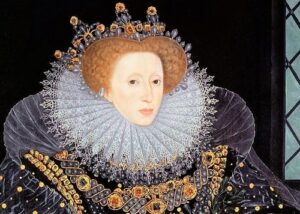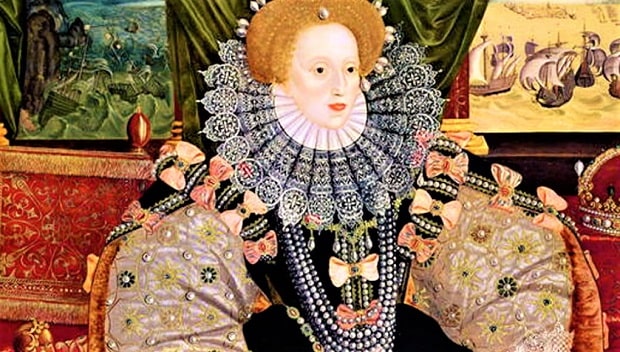Elizabeth I of England also knew as under the names of The Virgin Queen, The Maiden Queen, Gloriana or Good Queen Bess (born on September 7, 1533, in Greenwich, Died on March 24, 1603, in Richmond), was The Queen of England and Ireland from November 17, 1558, until the end of her life.
Elizabeth was the daughter of Henry VIII and the fifth and last member of the Tudor dynasty on the English throne. Her mother was Anne Boleyn. Her reign as Queen of England and Ireland from 1558 to 1603 the time was also known as an Elizabethan era.
At that time the Anglican Church received its final expression, numerous artistic works by dramatists such as William Shakespeare, Christopher Marlowe, or Ben Jonson emerged, poetry with sonnets and song-poems, it became the modern sciences with Francis Bacon Founded and circumnavigated the world of Francis Drake.
The first English colony in America was founded at this time and named Virginia in her honor. His reign of 44 years and 127 days has been the fifth-longest in English history, behind those of Elizabeth II, Victoria I, George III, and Edward III.
Quick Facts: Elizabeth I
- Born: 7 September 1533, Palace of Placentia
- Also Known As: Elizabeth Tudor, The Virgin Queen, The Maiden Queen, Gloriana or Good Queen Bess
- Known For: Queen of England
- Reign: 17 November 1558 – 24 March 1603
- Coronation: 15 January 1559
- Predecessors: Mary I and Philip
- Successor: James I
- Parents: Father – Henry VIII of England, Mother – Anne Boleyn
- House: Tudor
- Religion: Church of England
The Early Life of Elizabeth I
Elizabeth was the only surviving daughter of Henry VIII and his second wife, Anna Boleyn, with whom the sovereign had secretly married between the end of 1532 and the beginning of 1533. He was born in the Placentia palace in Greenwich, 7 September 1533, and was baptized three days later with the name of the grandmothers Elizabeth of York and Elizabeth Howard.
Henry VIII would have wanted a male to ensure succession, but given that Maria had been declared illegitimate with the annulment of the parents’ marriage, Elizabeth was, at the time, the presumed heir. After Elizabeth’s birth, Anna Boleyn became pregnant at least two or maybe three more times, but all pregnancies ended in miscarriages or born babies who died.

After the last abortion, in January 1536 Anna Boleyn fell definitively out of favor; accused of witchcraft, high treason, incest with her brother George Boleyn and of adultery with numerous courtiers, on May 2 she was locked up in the Tower of London and on 19 May she was beheaded; the following day Enrico got engaged to Jane Seymour, who had been the escort lady of Anna Boleyn and Catherine of Aragon.
Elizabeth, who was then three years old, was declared illegitimate, lost the title of princess, and was raised in exile in the Hatfield palace with her half-sister Maria, until Jane Seymour gave birth to a son, Edward, dying a few days later of puerperal fever.
Following the king’s unlucky wedding with Anna of Cleves, a German noblewoman, which took place in 1540, Elizabeth was admitted to the court and made a friendship with her stepmother that lasted until her death in July 1557.
Subsequently, the sixth wife by Henry, Caterina Parr, reconciled the king with his daughter who, together with his half-sister Maria, was reinserted in the line of succession after Prince Edward, with the act of succession of 1544.
Thanks to Catherine Parr, Elizabeth received an education in a rigidly Protestant environment, under the guidance of the humanist teacher Roger Ascham, studying Latin, Greek, French, Italian.
Mary I of England
King Edward VI died on July 6, 1553, at the age of 15. The letter patent which he wrote before his death was recognized as an act of treason, according to the law of Treason of 1547. Indeed, in full violation of the Third Act of Succession, it excluded Marie and Elizabeth from the succession and designated as successor to the throne Jeanne Gray, granddaughter of Marie Tudor Duchess of Suffolk, the sister of Henry VIII.
Jeanne Gray was proclaimed Queen by the Privy Council predominantly Protestant, but his support weakened as the Lords joined Mary, the legitimate queen. She was overthrown after nine days. Mary entered triumphantly into London on horseback with his half-sister Elizabeth at her side.
This testimony of solidarity between the two sisters did not last long. Mary I, a fervent Catholic (of Spanish mother), was determined to crush the Protestant faith in which Elisabeth had been educated and ordered that all her subjects attend Catholic Mass;
Elizabeth I was forced to comply apparently. The initial popularity of Mary I collapsed in 1554 when she married Prince Philippe II of Spain, Catholic and son of the emperor (and the king of Spain) Charles Quint. The discontent quickly spread across the country and many turned to Elizabeth.
On April 17, 1555, Elizabeth was recalled to court to attend the final stages of the apparent pregnancy of Mary I but when it became obvious that she was not pregnant, no one thought she could have a child. King Philippe, son of Charles V, who ascended the Spanish throne in 1556, recognized the new political reality and approached his sister-in-law.
Indeed, Queen Mary I of Scotland, Elizabeth’s cousin, could also claim the crown. Now she was engaged to the Dauphin of France with whom Spain was at war; When his wife fell ill in 1558, King Philippe sent the Duke of Feria to consult Elisabeth.
In October, Elizabeth was already preparing her government, and, on November 6, was recognized as her heiress by Mary I. On November 17, 1558, Mary I died and Elizabeth ascended the throne.
Ascension of Elizabeth I
Elizabeth I became queen at the age of 25 and declared her intentions to her council and other partners who had gone to Hatfield House to pledge allegiance. The speech contains the first account of his adoption of the medieval political theology of the “two bodies” of the sovereign: the natural body and the political body.
“Gentlemen, the law of nature makes me regret my sister; the burden that fell on me amazes me, and even so, considering that I am a creature of God, ordered to obey His appointment, I will thus surrender, wishing from the bottom of my heart that I can have the assistance of His grace to be my minister of His divine will in the position now committed to me. And as I am only one body naturally conceived, though by His permission as a political body to govern, so I wish you all … that you help me, that I with my government and you with your service may render good service to Almighty God and leave some comfort in our posterity on earth. I intend to take all my actions for good advice and consultation.”
She was warmly welcomed by citizens and greeted by prayers and parades, mostly in strong Protestantism, as she progressed through London triumphantly on the eve of her coronation ceremony. Elizabeth’s graceful and open responses delighted viewers, who were “wonderfully overwhelmed”.
[su_youtube url=”https://www.youtube.com/watch?v=cXW5LX6p9aY” width=”400″ height=”340″ title=”How to teach Kids”]
The next day, 15 of January of 1559, she was crowned and anointed in Westminster Abbey by Owen Oglethorpe, the Catholic Bishop of Carlisle. Isabel was then introduced to the acceptance of her people, amid the deafening sounds of organs, pipes, trumpets, drums, and bells.
Conflict with France and Scotland
The queen found a dangerous rival in her cousin, the Catholic Mary Stuart, Queen of Scotland, and wife of French King Francis II. In 1559, Maria Estuardo declared queen of England, supported by France.
In Scotland, Mary Stuart’s mother, Mary of Guisa, attempted to increase French influence in Britain by allowing the construction of French army fortifications on Scottish territory. A group of Scottish lords allied with Elizabeth succeeded in deposing Mary of Guise.
Under English pressure, Mary’s representatives signed the Treaty of Edinburgh, which ordered French troops to withdraw from Scotland. Although Mary vehemently refused to ratify the treaty, it had the desired effect, and the threat posed by France was removed from Britain.
When her husband died, Mary Stuart returned to Scotland. Meanwhile, in France, Catholic persecution of the Huguenots exploded the French Religious Wars. Isabel secretly helped the Huguenots. He made peace with France in 1564, giving up claiming the last English possession in mainland France, Calais, after the defeat of an English expedition at Le Havre.
Elizabeth, meanwhile, did not give up her claim to the French Crown, which had remained since the reign of Edward III during the Hundred Years’ War (14th century). Such a claim was only waived by the British monarchs in the reign of George III in the 18th century.
The Anglo-Spanish War
In 1580, Gregory XIII sent forces to help Desmond’s rebellions in Ireland which, however, failed. The rebellion was declared over in 1583. Meanwhile, Philip II acquired Portugal and, along with the Portuguese throne, received command of the high seas.
After the assassination of the Dutch statesman William of Orange, England began to openly support the United Provinces of the Netherlands, which were rebelling at that time against Spanish rule. This situation, together with the economic conflict with Spain and English piracy against Spanish colonies, led to the outbreak of the Anglo-Spanish War of 1585-1604.
In 1586the Spanish ambassador was expelled from England for his involvement in conspiracies against Elizabeth. Fearing such conspiracies, Parliament enacted the Association Act of 1584, which dictated that any associate in a conspiracy to assassinate the sovereign would be immediately excluded from the line of succession.
Despite the law, a subsequent coup attempt against Elizabeth took shape and became known as the Babington Conspiracy. The conspiracy was discovered by Sir Francis Walsingham, head of the English spy network. Maria Stuart was accused of complicity and was executed at Fotheringhay Castle on February 8, 1587.
In 1596 England finally withdrew from France, with Henry IV already fully established on the throne, after the defeat of the Catholic League that opposed him. Isabel sent 2,000 additional troops to France after the Spanish capture of Calais. England tried to attack the Azores in 1597 but failed.
Some battles still took place until 1598, when France and Spain finally made peace. The Anglo-Spanish War entered a phase of stagnation after the death of Philip II that year. Partly because of the war, overseas attempts at colonization by Raleigh and Gilbert failed, and American settlements stalled until James I negotiated peace in the 1604 Treaty of London.
The Last Year and Death
By the end of her life, the Queen began to realize that her appearance was no longer as attractive as before, and learned to skillfully distract attention from her face with expensive, richly adorned outfits, and the older she became, the more grandiose dresses became.
I must admit that she has always been distinguished by legibility in fashion. Besides, an increasingly thick layer of powder was present on her face. Due to the Queen’s strong passion for sweets, as well as the lack of personal hygiene, characteristic of all of Europe at that time, her teeth were in a very poor state by the end of her life – most simply rotted.
During the reign of Elizabeth I, more than 80 thousand people were executed only for vagrancy. In the last years of the death of close friends, the Queen’s health has been undermined. In February 1603, she fell into a deep depression and sadness.
On March 24, 1603, Elizabeth I died in Richmond Palace and was buried in Westminster Abbey. With the death of the Queen of the Tudor dynasty ended and started the Stuart dynasty, as his successor, Elizabeth I appointed James I, the son of Mary Stuart.


